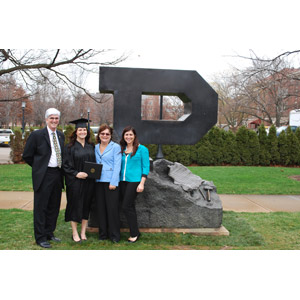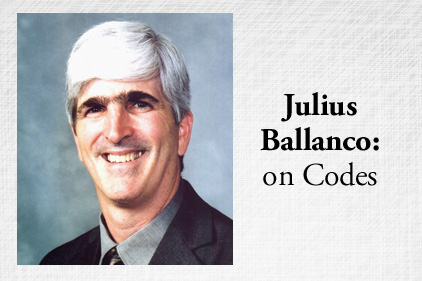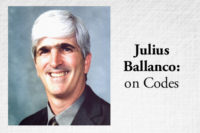
|
| My youngest daugther Kerriann’s recent college graduation made me think of all the changes that have ocurred in our profession since she was a little girl. That’s my wife, Judie, and daughter, XXXX, standing next to Kerriann. |
All three of my children now have college degrees. I had to fight back tears during the ceremony as a wave of nostalgia came over me. I thought about how a part of my life was coming to an end. I was somewhat sad and a little depressed. No longer would all the neighborhood friends hang out in our living room. They had become old enough to raid the beer in the refrigerator, which I gave them permission to do. Our house was always the lively place to be for the kids.
All Keri’s friends were good kids; polite kids. I will miss one of her friends who we always considered to be like Eddie Haskell from the 1960s TV show “Leave It to Beaver.” When he came in the house, he would always say: “Good evening, Mrs. B. My, you look mighty fine this evening.” If you are old enough, you will remember Eddie Haskell always saying the same thing.
For some reason, I recollected how Keri went to her first plumbing code hearing when she was nine days old. Then I thought back to when I first started writing professionally for plumbing engineering magazines. Keri was only a year-and-a-half, and pme did not yet exist.
I thought of the changes that have taken place in the plumbing engineering profession in that period of time. When we look at what we have accomplished on a year-to-year basis, it doesn’t seem like much. But going back to 1991 made me think of all the changes that have taken place. As my wife is fond of saying, “There truly has been a renaissance in the last 20 years.” It is good to take a look at the major progress we have made. That should inspire us to continue to improve our profession.
Changing for the better
In 1991, NSF 61 was just gaining some of its initial acceptance. Not all the chapters were complete in the standard, but we knew it would be groundbreaking. Many manufacturers thought it would just be another hoop to jump through. They soon learned that complying with the water quality requirements would not be easy. Every manufacturer of components used in potable water distribution systems had to change the way they did business. Some modified the brass they were using, while others added washing processes.
More recently, the federal government stepped in to limit the concentration of lead in drinking water components. Lead levels in drinking water have dropped significantly. We are providing the public with much safer water.
In the next year, every manufacturer will be switching to newer brasses. Some use silicon, others bismuth and still others use a variety of compounds. Do I worry about the new brasses? Yes. We have a long history with the leaded brasses. We don’t have a much of a history with the no-lead brasses. I hope all will be good in the next 20 years with the replacement brasses.
Another major change was to the temperature of hot water. When Keri was a year-and-a-half, only one plumbing code had mandated shower valves intended to prevent scalding. However, only a few states had adopted the code. Within a few years, every plumbing code added those requirements. The requirements expanded to bathtubs, bidets and even public lavatories. The plumbing engineering profession is completely attuned to protecting the public from scalding.
In 1991, none of the plumbing codes required secondary storm drainage. That would come a few years later. The storm requirements for designing the roof drainage system varied across the country. Now they are all the same. New sizing requirements are being introduced following the ASPE Research Foundation report on storm drainage sizing.
What’s the code?
Speaking of codes, there used to be four plumbing codes and many state-written plumbing codes. We are down to 2 1/2 codes. I call the National Standard Plumbing Code a half code since it is really a New Jersey-written code. It does not have the widespread acceptance of the International and Uniform plumbing codes.
We also are down to four state-written plumbing codes in Wisconsin, Illinois, Kentucky and Massachusetts. All the state-written codes are poor by comparison to the International and Uniform plumbing codes. Those remaining states would do their citizens a favor by switching to either the International or Uniform plumbing code. Perhaps in the next 20 years, I hope sooner, we’ll be down to a single national plumbing code.
Back then, standards differed in North America. Manufacturers had to follow one set of standards in the United States and another set in Canada. That made no sense and the industry has now harmonized the majority of fixture standards. One set of standards applies in both countries for plumbing products.
My company had been in business for only a year. We had a computer, but all the plans were still being drawn with pencils on a drawing board. I still have my drawing board templates, pencils, erasers, French curves, etc. I was ahead of my time because I had Design CAD on my computer, but the program was only good for creating drawings for books and training seminars. Of course, the seminars used transparencies and overhead projectors. AutoCAD didn’t become readily available for a few more years.
I can’t imagine doing a drawing today on anything but the computer. The last set of plans I submitted to the building department was done over the Internet because electronic plans were requested. Wow! What a change we have seen.
The week after Keri’s graduation, our family went to the theater to see the movie “It’s a Wonderful Life.” It really has been a wonderful life for Keriann. Her first 23 years have been great. It also has been a wonderful life for the plumbing engineering profession. We have made so many great strides, I just hope we continue.




